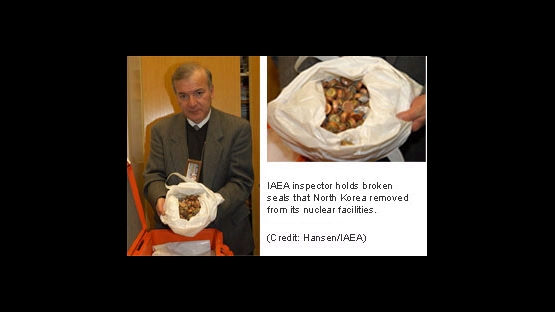The IAEA’s last inspectors to leave North Korea did not come home empty handed. They brought back all metal seals that North Korean authorities had cut at safeguarded nuclear facilities at the Nyongbyon site in December 2002, in preparation to restart nuclear operations frozen since 1994. Nuclear material under safeguards in North Korea is now left without any Agency monitoring.
On 6 January, the IAEA Board of Governors -- the Agency's 35-member policymaking body -- takes up the issue of nuclear safeguards in North Korea. They will consider a report from IAEA Director General Mohamed ElBaradei, who recently described North Korea’s actions as setting a “dangerous precedent” for the world’s regime to prevent the spread of nuclear weapons. A press briefing with the Director General is scheduled 6 January at the Vienna International Centre.
Dr. Yousry Abushady, IAEA Unit Head responsible for safeguards implementation in the DPRK, was the Agency’s key contact point for its inspectors in Nyongbyon. He recounted what happened when North Korean authorities took steps to reopen a sealed plutonium reprocessing plant, cutting the metal seals and disrupting surveillance equipment.
“The inspectors were asked to leave the country immediately,” he recalled. “But first our inspectors witnessed our surveillance equipment being turned off and our seals removed. The DPRK authorities covered all surveillance cameras and pointed them to the wall.”
Besides the broken seals, the inspectors managed to retrieve all video cards and tapes from the 15 cameras that once provided 24-hour monitoring at North Korea’s frozen nuclear facilities. Around one hundred North Korean officials and staff watched as all monitoring equipment was dismantled at Nyongbyon.
The IAEA inspects the North Korean nuclear programme under a safeguards agreement that Pyongyang concluded with the IAEA in 1992, pursuant to North Korea’s membership in the Treaty on the Non-Proliferation of Nuclear Weapons (NPT). Additionally, under a 1994 Agreed Framework between the North Korea and the United States, IAEA safeguards inspectors monitor specific nuclear facilities and activities that were “frozen” under that deal.
Dr. Kaluba Chitumbo, Head of the IAEA Safeguards Operations Division for the Asia Pacific region, explained that the IAEA’s role had two aspects. The first, to see that the “freeze” was in place and that North Korea’s nuclear facilities were not operating. The second, that safeguards were in place – to verify that nuclear material (such as spent fuel) was not diverted. In implementing their work, Dr. Chitumbo said that IAEA inspectors had provided the DPRK with a detailed list of what activities were required for the Agency’s respective monitoring and safeguards roles.
Mr. Abushady says during the time that IAEA inspectors were in the DPRK they were treated with respect and never feared for their safety. Their base was a simple guesthouse with basic amenities. An inspector’s mission in the DPRK would typically last two weeks, with two inspectors assigned to work together for three periods per year. During an inspection, normally they would visit more than one facility per day, which DPRK authorities would be notified about the previous evening. They would also conduct surprise inspections that were carried out within an hour.
As of early January 2003, it is an IAEA inspector assignment put on hold, pending the next steps in concerted efforts to resolve the North Korean nuclear issue.


